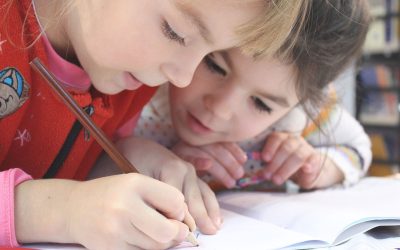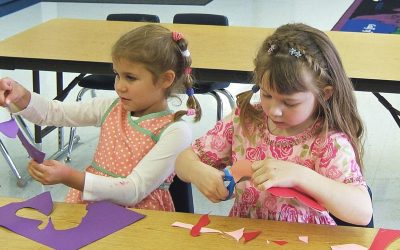You may also listen to the parent podcast with Joanne here.
Podcast Transcript:
[00:00:01.290] – Steve [Barkley]
Hello and welcome to the teacher edition of Steve Barkley Ponders Out Loud. The complexity of teaching is both challenging and rewarding, and my curiosity is piqued whenever I explore with teachers, the multiple pathways for facilitating student engagement in the exciting world of learning. This podcast looks to serve teachers as they motivate and support their learners. Thanks for listening. I’m delighted that you’re here.
[00:00:38.350] – Steve
Building and supporting students’ creativity. Dr. Joanne Foster is rejoining our podcast today with a look at teachers building and supporting student creativity. She earlier recorded a three part podcast series with us, and I’d encourage you to review that to deepen your understanding of the importance of creativity and ways to tap the possibilities. I’ve posted the link to those podcasts in the lead-in to this podcast. In addition, we just recently recorded another podcast for parents, and you’ll find that in the lead-in as well. Dr. Foster has worked in the field of gifted education for over 35 years. She has a master’s degree in special education and adaptive instruction, as well as a doctorate in human development and applied psychology. She taught educational psychology as well as gifted education for twelve years in the Teacher Education Program at the University of Toronto. She is an award winning author of eight books. She writes about intelligence, creativity, child development, motivation, procrastination, and more. Today, Joanne shares her experiences as a parent educator, consultant, and community advocate. Her newest book, “Ignite Your Ideas: Creativity for Kids,” has just been released. Welcome back, Joanne.
[00:02:11.690] – Joanne
Thank you so much. It’s a pleasure to be back and to be able to talk with teachers. I taught for many years at the University of Toronto in the Teacher Education program, so it’s wonderful to be able to have this opportunity. Thank you.
[00:02:27.200] – Steve
I’m wondering if you’d start us off talking a little bit about your passion around the idea of kids and adults working together to make creativity a part of their daily lives.
[00:02:40.230] – Joanne
Absolutely. I’m really passionate about creativity. I find it’s very empowering. It permeates every aspect of our lives. And it’s important to find ways to infuse creativity into everyday activities, whether it’s at home or school or anywhere, actually. It motivates, it enhances connections, it brings a lot of joy. And actually, creativity is at the heart of humankind’s advancements, whether it’s in technology, business ventures, education, the arts, sciences, whatever it happens to be. So I think that’s really why it’s important to work together in terms of helping children become more creative.
[00:03:27.270] – Steve
So I work with many schools that have somewhere in their mission or vision statements or their goals that they want students to be college and career ready. And some of them add life ready to that list, and that frequently leads to them having a focus on what they label as “the four C’s” – communication, collaboration, critical thinking, and creativity. I’m wondering if you would share your thoughts on the importance that you see in those four C’s.
[00:04:01.390] – Joanne
So communication, collaboration, and critical thinking are all very important and in fact, lead to creativity, which was your fourth C. So as much as I appreciate these three C words, and I think they’re really imperative, I’m going to give you some other ones to think about as well. So let’s just think about what else really matters in a classroom situation and in terms of making the most of children’s educational opportunities. So the first is choice, also an important C word. And creativity is in fact, a choice. Kids who get to choose various aspects of their learning, including the creative endeavors that they want to tackle, will be more invested in the process. There was ancient Greek philosopher who said that choices are the hinges of destiny. And I really think that that’s a beautiful quote. I like that. So choice is another C word. How about challenge? Life is full of challenges, and teachers, of course, are well positioned to help kids learn to problem solve and overcome them and again, use their creativity to do so. Caring is an important C word because a well functioning classroom has students who encourage and cooperate with one another, who are kind and courteous and compassionate, which are C words.
[00:05:19.450] – Joanne
Conviction – you have to have determination, enthusiasm, and passion for what it is you’re going to do or what it is you’re going to create. So teachers can certainly help students develop conviction, which can lead to confidence, in fact, another C word. Clarification – I think it’s important that teachers clarify expectations. Ideally, they co set them or co create them with their students so that they can ensure that whatever tasks are on hand are fair and fitting and adaptable, flexible for kids. Change is a C word. Change is a huge C word because it’s inevitable. And teachers can help kids adjust to new programs, new friends, new challenges, new expectations. Congratulations – this is one maybe you didn’t expect, but I think it’s an important one because we have to congratulate children on their efforts, build in that genuine praise, that encouragement, that reinforcement, even those small steps as they work towards and actually achieve their goals. So I should tell you that this is not off the top of my head. I actually have written a book called, “ABCs of Raising Smarter Kids” and the whole thing is done in alliteration, and every chapter is different letter of the alphabet.
[00:06:38.520] – Joanne
So if you want to find out more C’s, I’ve got them. You want to find out M’s for motivation, O for opportunities, you name it, it’s there. So “ABCs of Raising Smarter Kids,” I’ll give you the link to that. And for the record, just so you do know, communication, collaboration, critical thinking, and creativity, which was our starting point for this question, all of them are there.
[00:07:00.110] – Steve
Alright. So how about you, did congratulations. I frequently have celebration as one of my key ones, so they go together?
[00:07:12.990] – Joanne
Yeah. Dance like no one’s watching.
[00:07:15.310] – Steve
Yeah. You’ve written about the need to support teachers with professional development around enabling them to be better prepared to support all students and to meet the students needs both social-emotionally, academic, as well as other. What might PD to support and creativity like?
[00:07:40.950] – Joanne
Well, I’m going to start by answering this question in terms of thinking about how teachers can challenge themselves to become more effective. And they can do this by acquiring a wide range of tools, skills, resources, support. Sometimes we think of PD as strictly being sort of a group effort on a specific designated day that’s been assigned by the school board or what have you. But really it’s more than that. It is that, but it’s also the fact that teachers have to find various ways on their own too, as well as collaboratively in terms of learning opportunities, finding the conferences they want to attend, networking effectively, and finding other ways to build their skill sets and their confidence. Because ideally, what you want is for creativity to be happening in the classroom as often as it possibly can be. So you asked specifically, what does that PD actually look like in terms of supporting creativity in the classroom? So teachers can be thinking about what it is they currently do, how, when, and where they can connect productively with others, to see what kinds of things they do in their classrooms. Think about what your school or school board needs, what it lacks right now, and that might benefit the creative expression of both students and teachers.
[00:09:10.610] – Joanne
And I appreciate that teachers’ lives are really busy, so you don’t want to have to lay on more things for them to consider and do. But other things they might want to think about in terms of enhancing that creativity is to think about time management in their classrooms, the organizational things, the goal setting, the prioritizing, all of that and learn more about things like mindfulness and neuroplasticity, how the brain works and motivation and AI, which is like, wow, that’s a whole other topic, entrepreneurship, so many different things. How to make that optimal match between the student and the program. And in one of my other books, “Being Smart about gifted Learning,” Don and Matthew and I talk about that optimal match and how to make it happen, and different types of program development that can be put into place. I would be remiss if I didn’t talk about differentiation as being important also in terms of enhancing creativity. I mentioned in my previous podcast that I write for the Creativity Post and I’ll provide you with a link to an article on differentiation and creativity that I wrote for the Creativity Post, where I talk about how having a flexible range of options well suited to the individual child can really help them feel comfortable about infusing creativity into what it is they do when they tackle various tasks.
[00:10:41.870] – Steve
I don’t know why, but – maybe I do know why – your use of the word caring earlier, I’m hearing it carried over.
[00:10:55.890] – Joanne
Yeah, it is, for sure, but let me add one more thing. There’s also self care on the part of teachers, and that’s really important. Teachers who invest in their own creativity, who look after themselves and feel motivated when they walk in the room and happy about what it is they’re going to do, that carries out to the kids. They see that message, it’s conveyed by the teacher that creativity matters, that they’re looking after themselves, and they’re trying to really move forward in positive directions. So teachers might want to think of what kinds of professional development might help them be more creative, so they, in turn, can convey that to their students. So maybe it’s engaging in those collaborative ventures that school board or other places put on, or maybe it’s trying fresh approaches and strategies or applying something really new or potentially challenging. I listened recently to one of your previous podcasts where you talked about the “wow factor.” You described a teacher who brought in this box and told the students that they couldn’t open it until they figured out the volume. And then they got inside the box and there was this whole long thing of candy.
[00:12:09.890] – Joanne
Again, they couldn’t help themselves until they were able to divide it properly and share it equally. Anything like that is fun for the kids. It’s creative, it’s wonderful. But by the same token, it requires a lot of preparation on the part of the teacher. So as as an educator, and I myself taught in classrooms for many years, and, as I said, taught in the teacher training program at the University of Toronto. I think you have to be prepared for that effort and agency that I discussed in an earlier podcast, but also know that there are venues, there are ways and avenues to pursue in order to increase your own creativity, feel good about yourself, self care and personal growth, fulfillment.
[00:12:55.450] – Steve
You mentioned a little bit about AI, and I just recently read a short piece where a person did a rather creative thing as part of learning, and she was quick to add that the AI resource made it doable. So it gave her the opportunity, it was her idea, it was the teacher’s creativity, but the work of implementing it, she didn’t see that she would have had the time to do that. But the ability to go to AI and tap that AI resource allowed her to give something that she was excited about being able to give to the kids.
[00:13:36.380] – Joanne
Right, exactly. And I think this is a whole new frontier. And as we learn more about AI and how it will impact our children’s learning and ways of teaching, whether it’s instruction or whether it’s programming or whether it’s something else altogether, we’re on a learning curve, all of us. So we have to be smart about what we do.
[00:14:01.070] – Steve
So there may be a future book on AI and creativity? [laugh]
[00:14:04.506]
Maybe in the future. [laugh]
[00:14:04.650] – Steve
Your new book, “Ignite Your Ideas: Creativity for Kids,” contains specific strategies that students can employ to build their creativity, as well as strategies that teachers and others who support students can use. Can you share some of the examples of students using those activities for their creativity?
[00:14:33.850] – Joanne
Okay, so in terms of what students themselves can do, I think that the first thing is to appreciate that creativity matters in their lives, that they can use that creativity to bolster their thought processes, their outcomes, their journeys of learning. They have to think in terms of how I can self motivate. What is it that really gets me interested and alive and gets my creative juices flowing? What makes me feel good when I achieve something, even if, as I mentioned before, small steps that, as you say, we need to celebrate as well as congratulate. We have to help children understand that they have to build from what knowledge they already have to use that as a foundation or as a stepping stone to build new skills, new ideas, and to involve themselves in connecting with other people, staying engaged in what it is they’re trying to do, asking for help and support if they need it, and to take a look at some of the ideas, in fact, and ignite your ideas. I’ve got hundreds of strategies that will help students become more excited around infusing creativity. So those would be some of the pointers.








